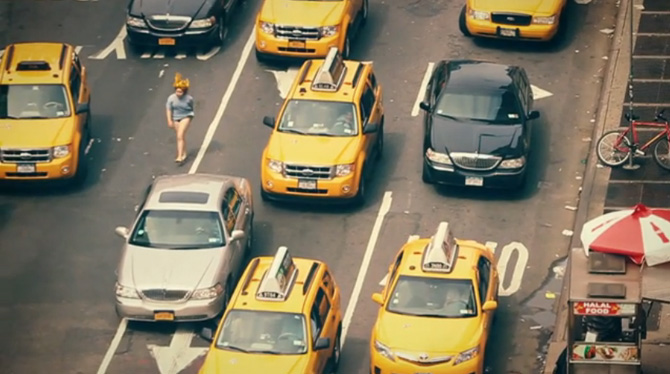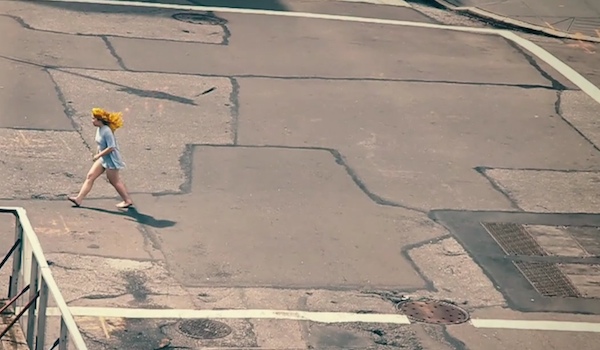In Ryan McGinley’s short film “Varud,” a young woman dressed for backyard summer play with a t-shirt as a dress and a gold lame wig skips through New York, altering the city as she goes. The film’s simple repetition and its dream-like collision between youthful exuberance and the mundane design of the city is perfectly captured in the slow skipping of the young woman down yellow meridian lines, among the gentle yellow taxis of New York traffic. It is both sublime and common, unspeakable beauty with a cheap wig, t-shirt dress, and bare feet.
The simplicity of the film makes the experience a more poetic than narrative experience. McGinley in his own words describes his intent:
“this piece is my poem to new york city. i wanted to bring a childhood innocence to the streets, through a character whose own light and wonder effects (sic) the world around her. i’m always interested in an atmosphere where dreams and reality mingle on equal terms.”
As the film unfolds, small details gather around the wonder: the orangey gold wig, as cheap as it might be, sheds bits of sunlight; pedestrians turn and watch her go by; she traverses even more extreme concrete and empty spaces like the highway off-ramp.
If McGinley had stopped there, with just the intervention of the young woman skipping through the city, that might have been what this film was about: a simple, sepia-with-joy filter to see the city through anew. But this city, McGinley’s city, is altered, ruptured. As the film progresses the city starts to seize up mid breath as though the young woman’s skipping, her strange combination of joy, youthfulness and alarming play, stop time. These pauses, these cessations, we can read as moments of reflection where the city’s denizens pause to glimpse some wonder among the asphalt, the crowds, the day-to-day.
Yet these are not simple pauses. They do not end. The only pause that ends is the final one where the girl fades into the sepia long light of the end of the day, and, ever so slowly, the frozen pedestrians find their stride once more.
Until this final moment of the film, the people she has passed have all remained frozen, caught, as though she has put the kingdom to sleep. And though there is a beauty in that, in this reflection, there is also something ominous and a little apocalyptic in it. As each street falls to silent pause, after pause, the film’s images recall the horror of other film cities left in stillness, like at the start of 28 Days Later and in the psychological twists of Vanilla Sky.
She leaves the city, as these other films do, not resembling itself, lacking its bustle, fury, and perpetual motion. It is the end of things, heralded by an innocent in a sparkly wig. Could there be a more grace-ful way to go?
What does it mean that the skipping girl not only stops time but does so repeatedly? There is something here of Sigmund Freud’s repetition compulsion: “an instinct is an urge inherent in organic life to restore an earlier state of things.’ Each repetition, each frozen moment she creates has her skipping past what might have been momentary encounters with wonder and towards an absence of time, and the philosophers will tell us that without time there is no being. Block after block she freezes the city. But this is what we expect from wonder. Beauty that potentially annihilates the self.
The music, with its indecipherable lyrics and at times choir-like arrangement, encourages a heightened emotional engagement. The film is # 6 in Sigur Ros’s The Valtari Mystery Film Experiment, one of the sixteen films that were made with the support of the Icelandic band. The sixteen were chosen from almost 800 entries. The press information for the project notes that
“valtari was sigur ros’s last album as a four-piece. An elegiac work; they didn’t feel much like talking about it, and so, instead asked a bunch [of] talented directors to make whatever they felt like making to go with music. These 16 films are the result. Sad, funny, beautiful, and, occasionally, plain bewildering, they represent just some of the available emotional responses to this most contemplative of sigur ros (sic) album.”
Sigur Ros’s atmospheric music inspires each of the directors to move to more poetic and less narrative pieces (though the Valtari film already analyzed by Nicholas Humphries for Numero Cinq at the Movies, Dash Shaw’s “Seraph,” is significantly more narrative). This poetic atmosphere of the music and the overall project makes it possible for “Varud’s” repetitions and slow, unfolding, and makes it possible for us to submit to its unspeakable and breathless wonder.
— R.W. Gray






This artist is amazing… I found great pictures of Ryan McGinley’s “Body Loud” in Art Days, here is the link! http://www.art-days.com/ryan-mcginley-body-loud/ Enjoy! 🙂